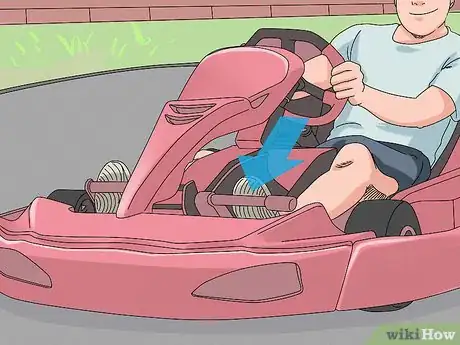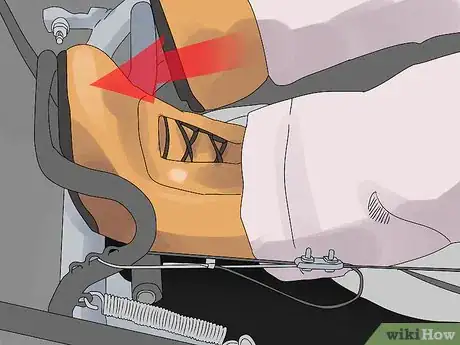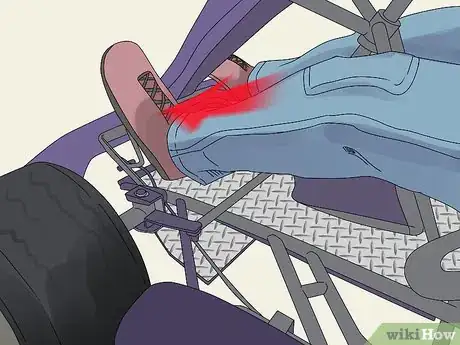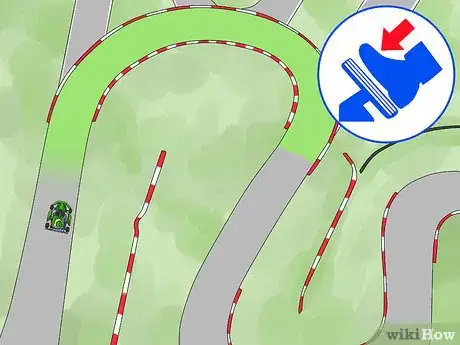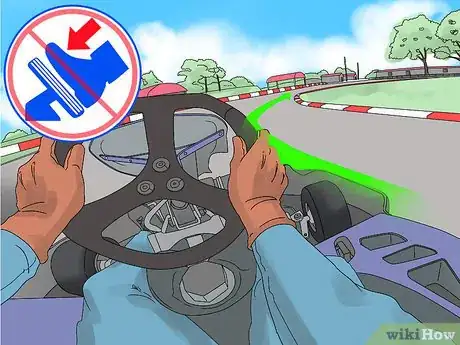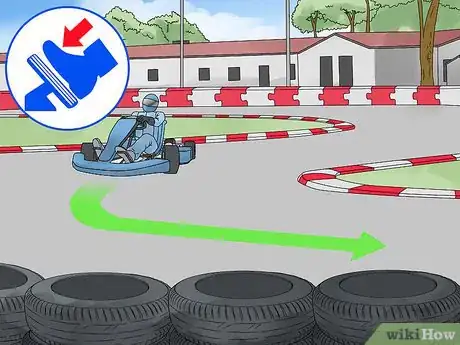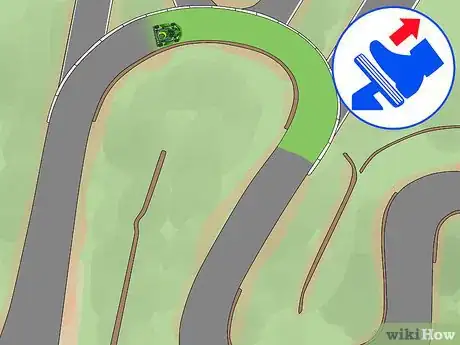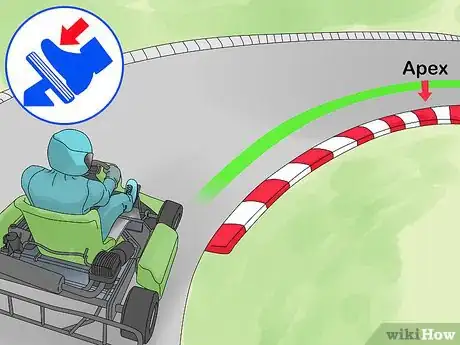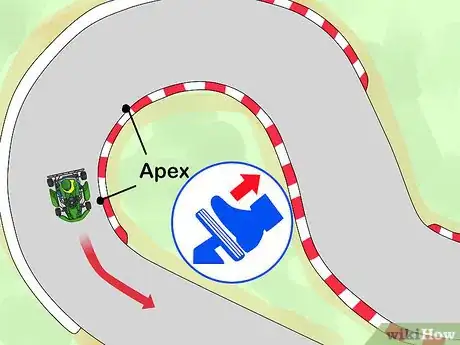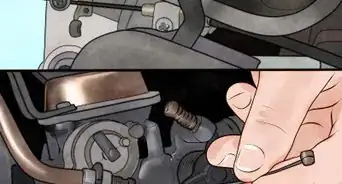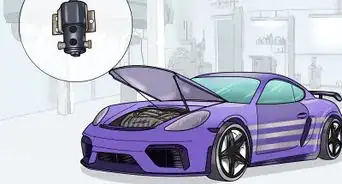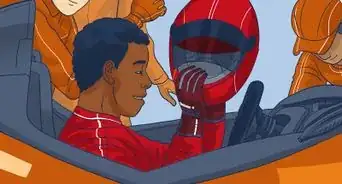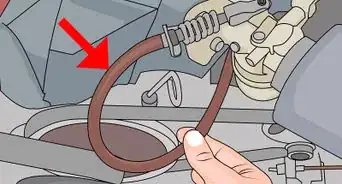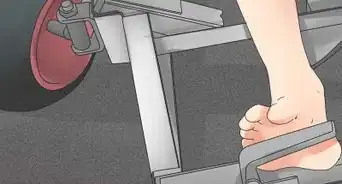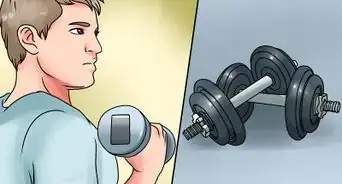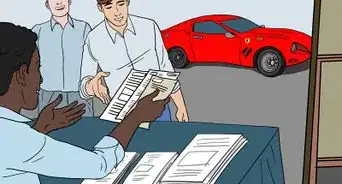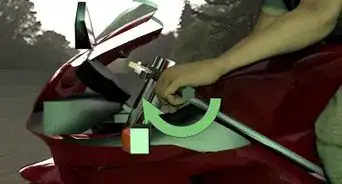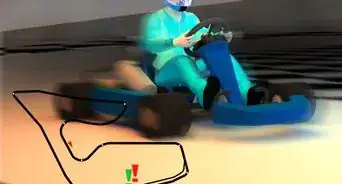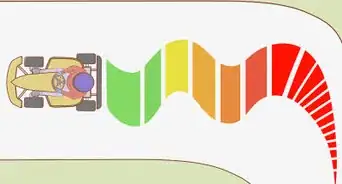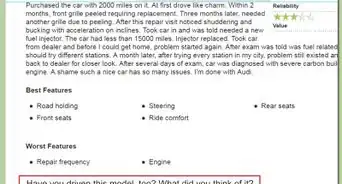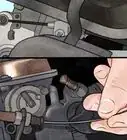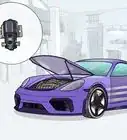This article was co-authored by wikiHow Staff. Our trained team of editors and researchers validate articles for accuracy and comprehensiveness. wikiHow's Content Management Team carefully monitors the work from our editorial staff to ensure that each article is backed by trusted research and meets our high quality standards.
There are 13 references cited in this article, which can be found at the bottom of the page.
This article has been viewed 84,292 times.
Learn more...
Braking when driving a go-kart is a delicate art. Before you do anything else, learn the braking system in the go-kart you're using, particularly if you need to use your left foot. After that, you can learn the basics of braking into a turn, and then move on to the more advanced trail braking, which gives you a slight advantage over other drivers. Try trail braking on longer, slower corners, rather than sharp, fast corners, and soon you'll be braking around corners like a pro![1]
Steps
Learning the Braking System
-
1Work on left-foot braking. In many go-karts, you can only brake with your left foot. Other go-karts give you the option. Either way, braking with your left foot can give you a split-second advantage over other drivers.[2]
- Breaking with your left foot saves you the time that it takes to switch from the accelerator to the brake and vice versa.
-
2Practice with your left foot to get better. If you're used to driving a car, you typically brake with your right foot. That means it's going to take some practice to become proficient at braking with your left foot. Spend some time practicing on the track before you race. Go out on the track when there are few cars, and consciously think about using your left foot to brake. Place it on the brake throughout your drive so you remember to use it.[3]
- If you can't seem to get the hang of it, switch back to braking with your right. If you're only so-so at braking with your left, then that's worse than just doing it with your right.
Advertisement -
3Hit the brakes as smoothly as possible. If you're jerky with your brakes, you're just going to slow yourself down. Slowly press down on the brake in 1 smooth motion, and then release as needed.[4]
- In other words, don't punch the brake multiple times to slow down.
Braking around Corners
-
1Brake in a straight line. Wait until you hit a straight part of the track before you brake. That way, the back end of the kart won't turn sideways on you. If it does, the friction of tires will slow you down too much, and you'll have lost time on the course.[5]
-
2Begin braking in the straight area just before the turn. Brake ahead of the turn, rather than in the turn. Press down on the brake in a controlled manner. Leave enough room so that you can stop braking before you hit the turn.[6]
- Pick a place on the straight part of the track to start braking. Note how well it works for you, and adjust the spot in the next curve.
- Brake a bit sooner if you're spinning out in the curve or a bit later if you're taking curves too slowly.
-
3Stop braking when the track begins to curve. As you enter the curve and start turning your car, pull your foot off the brake. You shouldn't be accelerating yet, but you are going to stop slowing down the car.[7]
- Accelerate when you hit the apex of the turn, which is the final part of the turn where you start straightening out.
-
4Get ready for the next corner as you come out of the last one. On a go-kart track, curves make up the majority of the track. That means you always need to be looking for your next curve. Look ahead, and pinpoint where you need to start braking for the next braking while still in the last curve.[8]
Performing Trail Braking
-
1Begin braking ahead of the curve. Just like in less advanced braking, you still want to begin braking well ahead of the curve while you're still in a straight line. In fact, you will apply the maximum amount of force while you're still in the straight line just ahead of the curve.[9]
- Trail braking can help you take corners faster because you're using more of the tire grip available to you. It helps you turn the car around the corner.[10]
-
2Pull off the brake as you increase your turning angle. When you enter the curve, start taking your foot off the brake. Initially, release a lot of the brake quickly, but still keep some pressure on. As you do, turn in a bit more sharply toward the curve to get ready for the apex of the turn.[11]
- You want to keep about 15 to 20% of the pressure on the brake as you come into the curve.[12]
-
3Keep your foot on the brake until the apex. In long slow curves, you can hold on to the brake until you reach the apex. That will help provide you with the extra spin you need to get around the curve[13]
-
4Release the brake completely when you reach the apex of the curve. You shouldn't be braking when you hit the main part of the curve, so release the pressure completely. On longer curves, wait for the apex. On medium curves, release just before the apex.[14]
Community Q&A
-
QuestionHow much should I push the brake?
 Community AnswerJust as much as you feel comfortable with your speed. Push it all the way down for a full stop and only a little bit if you want to go fast but slow up a little. It is up to you.
Community AnswerJust as much as you feel comfortable with your speed. Push it all the way down for a full stop and only a little bit if you want to go fast but slow up a little. It is up to you. -
QuestionWhat if my tires are worn down so they're almost square?
 Corey CoxCommunity AnswerYou should seriously think about pitting and getting some new tires! You'd have to be racing for about 5 hours straight, slamming on the brakes at every corner for that to happen.
Corey CoxCommunity AnswerYou should seriously think about pitting and getting some new tires! You'd have to be racing for about 5 hours straight, slamming on the brakes at every corner for that to happen. -
QuestionWhat would happen if I were to slam on the brakes? Would I injure myself?
 Community AnswerThat depends on two things: How fast you were going and if you were wearing your seat belt properly. If you are going really fast, you are likely to be injured and if you have no seat belt on, then you most likely will be hurt.
Community AnswerThat depends on two things: How fast you were going and if you were wearing your seat belt properly. If you are going really fast, you are likely to be injured and if you have no seat belt on, then you most likely will be hurt.
References
- ↑ https://www.racingjunk.com/news/2016/11/11/understanding-trail-braking/
- ↑ https://speedsecrets.com/driving-tips/the-pros-cons-of-left-foot-braking/
- ↑ https://speedsecrets.com/driving-tips/the-pros-cons-of-left-foot-braking/
- ↑ https://www.youtube.com/watch?v=Z23FKnJKmvc&feature=youtu.be&t=105
- ↑ https://www.youtube.com/watch?v=Z23FKnJKmvc&feature=youtu.be&t=38
- ↑ https://www.youtube.com/watch?v=rPgSTQHzAN4&feature=youtu.be&t=33
- ↑ https://www.youtube.com/watch?v=rPgSTQHzAN4&feature=youtu.be&t=33
- ↑ https://www.wrkc.on.ca/wp-content/uploads/2013/01/Kart_Driving_Secrets.pdf
- ↑ https://www.youtube.com/watch?v=tvcuGoVhpxw&feature=youtu.be&t=81
- ↑ https://www.youtube.com/watch?v=tvcuGoVhpxw&feature=youtu.be&t=329
- ↑ https://www.youtube.com/watch?v=tvcuGoVhpxw&feature=youtu.be&t=110
- ↑ https://www.youtube.com/watch?v=tvcuGoVhpxw&feature=youtu.be&t=157
- ↑ https://www.racingjunk.com/news/2016/11/11/understanding-trail-braking/
- ↑ https://www.racingjunk.com/news/2016/11/11/understanding-trail-braking/
- ↑ https://www.racingjunk.com/news/2016/11/11/understanding-trail-braking/
